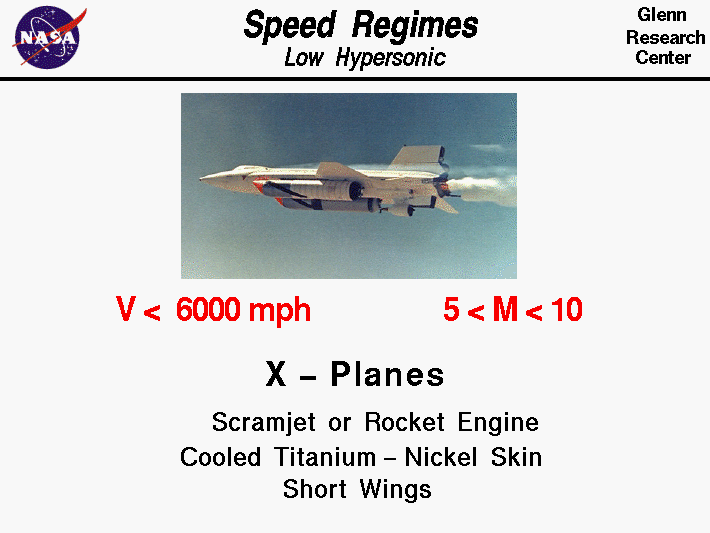
|
This page is intended for college, high school, or middle school students.
For younger students, a simpler explanation of the information on this page is
available on the
Kid's Page.
|

As an aircraft moves through the air, the air molecules near the
aircraft are disturbed and move around the aircraft.
Exactly how the air re-acts to the aircraft depends upon the
ratio of the speed of the aircraft to the
speed of sound through the air.
Because of the
importance of this speed ratio, aerodynamicists have designated it
with a special parameter called the
Mach number
in honor of Ernst Mach, a late 19th century physicist who studied gas
dynamics.
For aircraft speeds which are much greater than the speed of sound,
the aircraft is said to be hypersonic.
Typical speeds for hypersonic aircraft are greater than 3000 mph
and Mach number M greater than five,
M > 5.
We are going to define a
high hypersonic
regime at M > 10 to account for re-entry aerodynamics.
The chief characteristic of hypersonic aerodynamics is that the
temperature
of the flow is so great that the chemistry of the diatomic molecules of the
air
must be considered. At low hypersonic speeds, the molecular bonds
vibrate, which changes the magnitude of the forces generated by
the air on the aircraft. At high hypersonic speeds, the molecules
break apart producing an electrically charged plasma around the
aircraft. Large variations in
air density
and
pressure
occur because of
shock waves, and
expansions.
The only manned aircraft to fly in the low hypersonic regime were the
X-15 and the Space Shuttle during re-entry. The X-15 is shown on the figure.
The X-15 used a
rocket
propulsion system to achieve sustained Mach 6 flight.
Recently, an un-manned X-43A used a
scramjet,
or supersonic combustion
ramjet,
to make two hypersonic flights; one at Mach 7, the other at Mach 10.
Because of the pressure losses associated with the
terminal shock
of the
inlet,
a ramjet has very limited performance beyond Mach 5.
Because
lift
and
drag
depend on the square of the
velocity,
hypersonic aircraft do not require a large
wing area.
For Mach numbers greater than 5, the frictional heating of
the airframe by the air becomes so high that
very special nickel alloys are required for the
structure. For some proposed hypersonic aircraft,
the skin is actively cooled by circulating fuel through
the skin to absorb the heat.
Activities:
Guided Tours
Navigation ..




- Beginner's Guide Home Page
|
